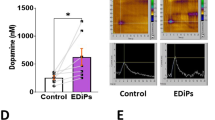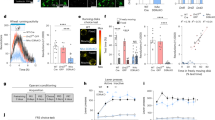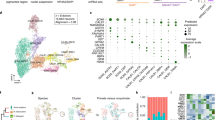Abstract
CENTRAL dopamine (DA)-containing neurones are thought to be involved in several human diseases including Parkinson's disease and schizophrenia, and to act as sites of action of some drugs of abuse. One of these DA systems, the nigrostriatal projection (NSP), has its origin in the substantia nigra (SN), pars compacta and innervates the caudate-putamen (CP). In the SN the dendritic processes of DA neurones have been shown to contain DA and vesicles1–3 and there is evidence that DA can be released by cells in the SN4–6. It has therefore been proposed that one mechanism by which the activity of DA neurones is regulated is through the action of dendritically released DA on hypothesised ‘autoreceptors’ on DA perikarya or dendrites7–9. Recently, however, this view has been challenged by the observation that DA-sensitive adenylate cyclase, an enzyme thought to be coupled with the DA receptor10, is located on terminals of the striatonigral or pallidonigral projection11,12 rather than on the DA cells themselves13–15. Similarly, in the CP where the existence of autoreceptors on DA terminals has been suggested16, the DA-sensitive adenylate cyclase has been shown to be localised on postsynaptic structures rather than on the DA terminals17,18. An established method for studying the DA receptor involves measuring DA receptor binding with labelled DA agonists or antagonists19,20. To further elucidate the location of DA receptors in the SN and CP, we have examined the effects of selective lesions of the NSP on labelling of DA receptors in these structures. These lesions, which are placed in the axons of the NSP, are known to cause near-complete anterograde and retrograde degeneration of the terminals and cell bodies of this system21. The advantage of this lesion technique over previous approaches is that it avoids nonspecific damage of the areas studied. Our results provide direct evidence of presynaptic and postsynaptic dopamine receptors in rat brain.
This is a preview of subscription content, access via your institution
Access options
Subscribe to this journal
Receive 51 print issues and online access
$199.00 per year
only $3.90 per issue
Buy this article
- Purchase on SpringerLink
- Instant access to full article PDF
Prices may be subject to local taxes which are calculated during checkout
Similar content being viewed by others
References
Hajdu, F., Hassler, R. & Bak, I. J. Z. Zellforsch. 146, 207–221 (1973).
Bjorklund, A. & Lindvall, O. Brain Res. 83, 531–537 (1975).
Parizek, J., Hassler, R. & Bak, I. J. Z. Zellforsch. 115, 137–148 (1971).
Geffen, L. B., Jessell, T. M., Cuello, A. C. & Iversen, L. L. Nature 260, 258–260 (1976).
Korf, J., Zieleman, M. & Westerink, B. H. C. Nature 260, 257–258 (1976).
Nieoullon, A., Cheramy, A. & Glowinski, J. Nature 266, 375–377 (1977).
Aghajanian, G. K. & Bunney, B. S. in Frontiers in Neurology and Neuroscience Research (eds Seeman, P. & Brown, G. M.) 4–11 (University of Toronto Press, 1974).
Groves, P. M., Wilson, C. J., Young, S. J. & Rebec, G. U. Science 190, 522–529 (1975).
Bunney, B. S. & Aghajanian, G. K. in Pre- and Postsynaptic Receptors (eds Usdin, E. & Bunney, W. E.) 89–122 (Dekker, New York, 1975).
Kebabian, J. W., Petzold, G. L. & Greengard, P. Proc. natn. Acad. Sci. U.S.A. 69, 2145–2149 (1972).
Gale, K., Guidotti, A. & Costa, E. Science 195, 503–505 (1977).
Spano, P. F., Trabucchi, M. & DiChiara, G. Science 196, 1343–1345 (1977).
Kebabian, J. W. & Saavedra, J. M. Science 193, 683–685 (1976).
Phillipson, O. T., Emson, P. C., Horn, A. S. & Jessell, T. Brain Res. 136, 45–58 (1977).
Spano, P. F., DiChiara, G., Tonon, G. C. & Trabucchi, M. J. Neurochem. 27, 1565–1568 (1976).
Kehr, W., Carlsson, A., Lindqvist, M., Magnusson, T. & Atack, C. V. J. Pharm. Pharmac. 24, 744–747 (1972).
Schwarcz, R. & Coyle, J. T. Brain Res. 127, 235–249 (1977).
McGeer, E. G., Innanen, V. T. & McGeer, P. L. Brain Res. 118, 356–357 (1976).
Seeman, P., Lee, T., Chau-Wong, M., Tedesco, J. & Wong, K. Proc. natn. Acad. Sci. U.S.A. 73, 4354–4358 (1976).
Burt, D. R., Enna, S. J., Creese, I. & Snyder, S. Proc. natn. Acad. U.S.A. 72, 4655–4659 (1975).
Clavier, R. M. & Fibiger, H. C. Brain Res. 131, 271–286 (1977).
Fibiger, H. C., McGeer, E. G. & Atmadja, S. J. Neurochem. 21, 373–385 (1973).
McGeer, E. G., Gibson, S. & McGeer, P. L. Can. J. Biochem. 45, 1557–1563 (1967).
Chalmers, A., McGeer, E. G., Wickson, V. & McGeer, P. L. Comp. gen. Pharmac. 1, 385–390 (1970).
Hattori, T., Fibiger, H. C. & McGeer, P. L. J. comp. Neurol. 162, 487–504 (1975).
Leysen, J. E., Gommersen, W. & Laduron, P. M. Biochem. Pharmac. 27, 307–316 (1978).
Ungerstedt, U. Acta physiol. scand. 82, suppl. 367 69–93 (1971).
Price, M. T. C. & Fibiger, H. C. Eur. J. Pharmac. 29, 249–252 (1974).
Christensen, A. V., Fjalland, B. & Moller-Nielsen, J. Psychopharmacology 48, 1–12 (1976).
Muller, P. & Seeman, P. Life Sci. 21, 1751–1758 (1977).
Burt, D. R., Creese, I. & Snyder, S. H. Science 196, 326–328 (1977).
Creese, I., Burt, D. R. & Snyder, S. H. Science 197, 596–598 (1977).
DiChiara, G., Porceddu, M. L., Spano, P. F. & Gessa, G. L. Brain Res. 130, 374–382 (1977).
Iversen, L. L., Rogawski, M. A. & Miller, R. J. Molec. Pharmac. 12, 251–262 (1976).
Christiansen, J. & Squires, R. F. J. Pharm. Pharmac. 26, 367–369 (1974).
Carlsson, A. in Pre- and Postsynaptic Receptors (eds Usdin, E. & Bunney, W. E.) 49–65 (Dekker, New York, 1975).
Strombom, U. Acta physiol. scand., Suppl. 431 (1975).
Creese, I., Burt, D. R. & Snyder, S. H. Life Sci. 17, 993–1002 (1975).
Author information
Authors and Affiliations
Rights and permissions
About this article
Cite this article
NAGY, J., LEE, T., SEEMAN, P. et al. Direct evidence for presynaptic and postsynaptic dopamine receptors in brain. Nature 274, 278–281 (1978). https://doi.org/10.1038/274278a0
Received:
Accepted:
Published:
Issue date:
DOI: https://doi.org/10.1038/274278a0
This article is cited by
-
Screening of dopamine in living cells and animal model via graphene quantum dots anchored 3D macroporous nonenzymatic sensor
Microchimica Acta (2022)
-
Dopaminergic neurotoxicity following pulmonary exposure to manganese-containing welding fumes
Archives of Toxicology (2010)
-
Effect of dopamine and haloperidol on the c-wave and light peak of light-induced retinal responses in chick eye
Documenta Ophthalmologica (1987)
-
Autoradiographic localisation of3H-apomorphine binding sites in rat brain
Naunyn-Schmiedeberg's Archives of Pharmacology (1985)



